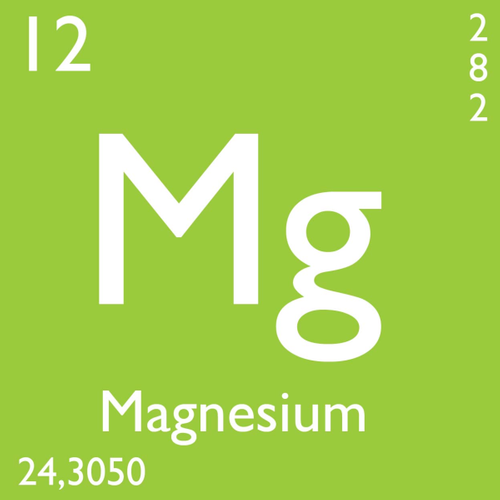Magnesium (Mg) has several purposes in the plant, one of the main ones being the central position in the ring of the chlorophyll molecule. Thus, it is very important for plant photosynthesis. The other roles magnesium has in plants are parts in respiration and energy metabolism. Magnesium is considered a secondary plant nutrient, because it is needed in fairly large amounts by plants.
Magnesium moves with the water to the roots of the plant as the cation Mg2+, meaning the plant does not actively take it up and making root surface size and area an important factor in accumulation. Therefore, Mg2+ deficiency can occur when root growth is comprised or the soil is too dry. Interpreting soil analyses for magnesium content is not easy, because it is usually not the total amount that determines whether a deficiency can occur, but the relative proportion of Mg to calcium and potassium in the soil. Furthermore, high levels of magnesium can cause deficiencies of these other nutrients as well.
When interpreting soil analyses, bear in mind that “exchangeable Mg2+” and “saturated paste analysis Mg2+” are not measuring the same thing. Only a percentage of exchangeable Mg2+ is available to the plant at any given time, the rest being bound to soil particles, colloids and organic matter. The saturated paste analysis better represents what the plant root would encounter at the time of sampling, but this number will vary with the amount of rain or irrigation at that time.
A rule of thumb would be that saturated paste soil test values for Mg2+ above 0.5 meq/l represent sufficient amounts. Pajaro and Salinas Valley soils tend to be well above this threshold and thumbing through my numerous soil analyses taken from these areas from the past few years, I'm not finding a single one underneath it.
Being as they are fundamentally chemistry labs, many soil analysis reports will be expressed in other units. Some labs report soil magnesium as ppm exchangeable Mg, for example “82 ppm”. For magnesium, meq/100 g x 120 = ppm. Therefore, 82 ppm Mg is the same as 0.7 meq. Luckily, most labs also provide some sort of graph that shows where the nutrient lands on the sufficiency index. Most soils are not considered deficient unless exchangeable Mg is less than 25 – 50 ppm.
Magnesium comes from rock and clay particles as they weather over time. The needs of strawberries and caneberries are around 40 -100 lb of Mg2+ per acre per season, meaning that soil analysis prints above several hundred pounds or even in the thousands in the top six inches indicate sufficiency (Mg ppm x 2 = lbs/top 6” of soil). Again, since this is measured as exchangeable magnesium, not all of it is available at any given time.
A low soil pH under 5.4 can be restrictive for plant magnesium availability, and to a lesser extent (because there is so much magnesium already around) other cations such as potassium and calcium can also contribute to deficiency. For example, plant deficiencies of magnesium can occur in soils where the calcium to magnesium ratio (Ca/Mg ratio) exceeds 7 on a meq basis. High levels of exchangeable potassium can also interfere with magnesium uptake. Conversely, the opposite is true. For example, in soils derived from serpentine rocks exchangeable magnesium can exceed calcium. This can cause some interesting plant growth characteristics in other crops, such as yellow shoulder in tomatoes where these are grown on high magnesium soils common to the west side of the San Joaquin Valley.
Looking at the revision of plant nutrient levels produced by Tim Hartz et al in 2012, sufficiency levels of Mg in strawberry leaf tissue are 0.33 – 0.45 % prior to the onset of fruiting and then at 0.2 to 0.4 % during the harvest season. In caneberries, according the Dr. Bernadine Strik at OSU, the optimum range is just a bit higher, with recommended values being 0.3 to 0.6 % during fruiting.
http://www.oregon-strawberries.org/attachments/2013-May_Nutrient_Management_Berry_Crops_OSU.pdf
Really a take home conclusion here is that most, if not all, of our Pajaro and Salinas Valley soils are well supplied with magnesium, and any deficiencies, should they arise, are stemming from physiological problems of the plant or chemical properties of the soil.
Attached Images:
